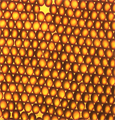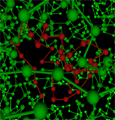

 |
 |
 |
Purpose and Focus
A wide variety of systems, examples of which include granular materials, liquid crystals, colloidal suspensions, surfactant mixtures, polymeric liquids, and biological matter, are broadly classified as complex fluids because they have an intricate microstructure that crucially influences their material properties.
These systems are inspiring several new and revolutionary technologies, and the key experimental and theoretical challenge has been to describe their thermodynamic phase diagram, and flow behavior, by understanding the connections between their microscopic structure and macroscopic properties. While an accurate description of any one of these systems necessitates experimental and theoretical techniques that are particular to that system, they all share at least three common features.
In each of these systems, the existence of complex microstructure implies that they can be described at different levels of detail, and depending on the typical time scales that one wishes to explore, a choice must be made of the relevant variables. This a priori choice of a coarse-grained or mesoscopic level of description is a fundamental feature of all complex fluids, and it is consequently vitally important to understand the universal features of coarse-grained systems, such as the thermodynamic consistency of a mesoscopic model, and the interrelationship between levels of coarse-grained description. Next >>